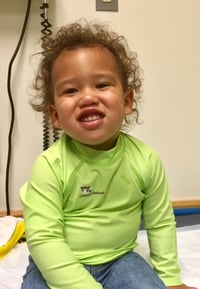

Whether your child has a first, second or third degree burn injury, the Burn Team at Children's National is here to guide you through this challenging time. After a burn specialist has evaluated and treated your child's burn, it is important to follow the specialist’s recommendations for continued treatment at home.
Dressings act as a substitute layer of skin to prevent infection and help with healing. Our specially-trained burn specialists may recommend any of the following:
- Mepilex Ag® silver dressing: A long acting dressing. Do not clean the burn. Keep the dressing dry and covering the burn. No bathing, swimming or showering. The dressing will be removed/changed at your next clinic appointment in about two to five days
- Silvadene Cream 1%® burn cream: Clean the burn once a day and apply a new Silvadene dressing. Apply a thin layer of cream to gauze and place the gauze directly on the burn with the cream on the skin. Secure gauze in place
- Xeroform® Bismuth Tribromophenate gauze dressing: Clean the burn once a day; then apply a strip of Xeroform over the burn and secure
- Bacitracin® topical antibiotic ointment: Wash the burn two to three times a day then apply a thin layer of Bacitracin over the burn and cover
- Aquaphor® moisturizer healing ointment: Apply a thin layer twice a day to healed skin or as recommended. Keep skin protected from sun exposure
Seek medical care if your child has any of the following:
- Persistent fevers greater than 101.5° F, difficulty breathing or increased sleepiness
- Thick, bad smelling fluid from the burn wound
- Redness around the burn
- Bleeding that continues after applying constant pressure for two minutes
- A dressing that will not stay in place or has moved off the burn and you can see the burned area
- Outer dressing that is completely wet
- Pain that does not go away after using recommended pain medications or if your child will not eat
After Your Child's Burn Heals
 Minimize sun exposure to prevent scarring; our burn team experts also recommend wearing protective clothing such as sun shirts, which our team can help patients obtain
Minimize sun exposure to prevent scarring; our burn team experts also recommend wearing protective clothing such as sun shirts, which our team can help patients obtain- Second and third degree burns may take several weeks to heal. These burns may cause scarring; and it can take weeks to months for the appearance to improve
- Massage the wound at least twice a day, focusing pressure on any areas that are hard, elevated or itchy
- Use compression garments (if recommended) to decrease scar growth and itching by putting pressure on the burn
- Cica Care Silicone gel sheets may help decrease scarring

Contact Us
Throughout your child's healing process, please contact the burn team if you have any immediate questions or concerns. We are here to support you.
Children's National Patient Portal
Urgent Matters
Appointments
Front Desk
Hours
The Burn Clinic is open on the following days and times:
- Mondays: 8:15 a.m. to 11:30 a.m.
- Wednesdays: 8:15 a.m. to 11:30 a.m. and 1:00 p.m. to 4:00 p.m.
- Fridays: 8:15 a.m. to 11:30 a.m.






